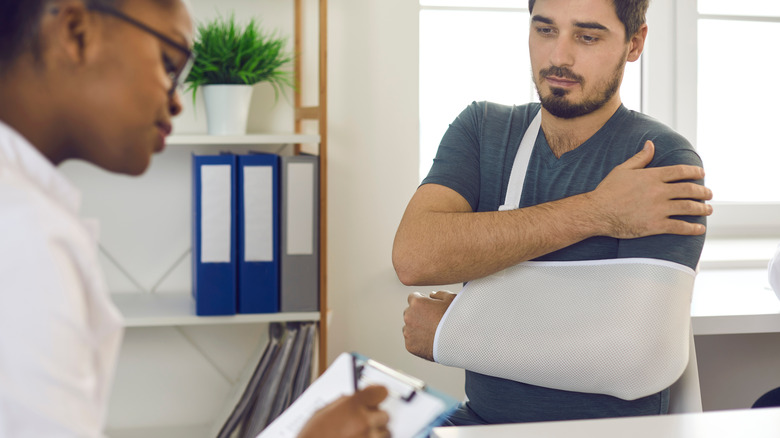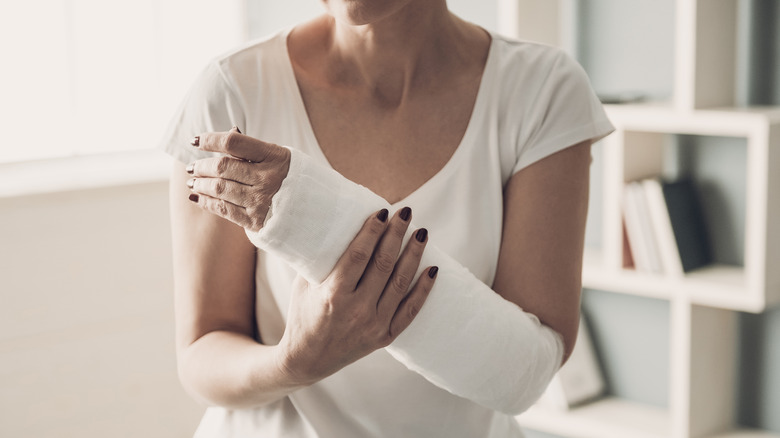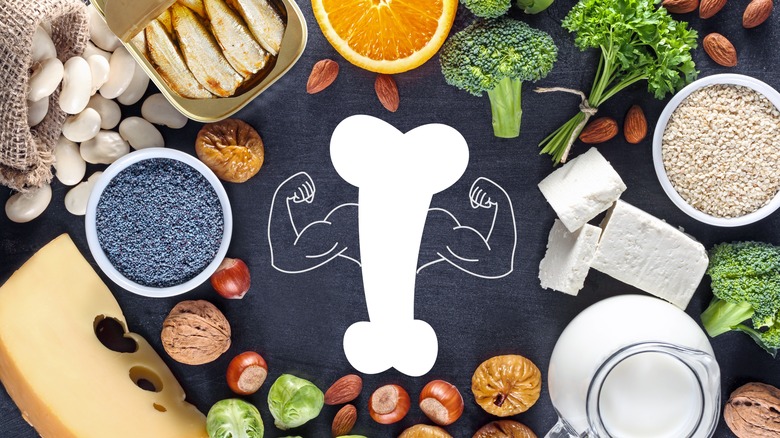The Top Three Most Common Bones To Break (& Why), According To Our Doctor
Our bones provide our bodies with the support and stability required for everyday tasks, from simple gestures to intense physical activities. An adult has 206 bones.Technically, any of them can be fractured in a fall or other accident, but some bones are more likely to require treatment. For instance, the distal radius (or wrist) is the most commonly broken arm bone (per the American Academy of Orthopaedic Surgeons). Cedars Sinai states that the humerus (upper arm bone) is a common injury. At the same time, Johns Hopkins Medicine reports that the collarbone, or clavicle, is also one of the most frequently broken bones.
Whether you've had a moment of clumsiness or experienced an accident, your clavicle, arm bones, and wrists often bear the brunt of the impact, making them susceptible to fractures. From the clavicle's delicate elegance to the arm bones' versatile adaptability and the wrists' intricate inner workings, you can discover the reasons behind their vulnerability to fractures by exploring the unique properties of each of these bones.
Collarbone cracks
The clavicle plays an essential role in the movement and stability of the upper body. This curved bone connects the shoulder blade to the breastbone and allows for a wide range of motion in the shoulder joint. Unfortunately, it's also quite susceptible to fractures. According to Thomas P. Bentley and Shayan Hosseinzadeh's book, "Clavicle Fractures," not only are up to 10% of all fractures clavicle fractures, but it's also the most common childhood fracture.
Dr. Amish Naik, Hand and Upper Extremity Orthopedic Surgeon at The Musculoskeletal and Sports Medicine Institute at Cooperman Barnabas Medical Center, sheds light on this matter. "Clavicle fractures can primarily result from a direct blow to the chest or fall onto the upper extremity, often occurring during sports like skiing or even simple standing falls," Dr. Naik told Health Digest exclusively.
The clavicle is just beneath the skin's surface and lacks significant muscle protection. Its unique S-shaped structure makes it a natural weak point prone to fracture upon impact. Breaking your collarbone can be more than just a painful experience. It can significantly limit daily activities like lifting things or reaching up high. Fortunately, most collarbone fractures can be healed with simple treatments like rest and wearing a sling.
Why arm bones take a hit
The humerus and radius are two of the most important bones in the human arm, enabling us to perform a wide range of movements and activities. However, they are frequently exposed to forces during falls or high-impact activities that lead to fractures.
"The wrist is susceptible to fractures due to various accidents and activities," revealed Dr. Naik. "High-energy activities like skiing, snowboarding, and bicycling can lead to wrist fractures in young people. In contrast, older individuals are more prone to falls at home or nighttime falls. Beyond 65, the risk of bone fractures increases, primarily due to conditions like osteoporosis, which weaken bones."
Jacob E. Tulipan, MD, orthopaedic surgeon at Rothman Orthopaedics at AtlantiCare, reports that, along with falls, many arm fractures are caused by vehicle accidents. "Falls can include slips and falls to falling from rooftops. Nearly everyone's instinct is to throw their hands out to break their fall," Dr. Tulipan told Health Digest exclusively. "Wrists are also at risk for breaking in crashes involving enclosed vehicles. That's because the hand and wrist take the impact of the crash as the driver grasps the steering wheel."
A humerus or radius fracture can be painful and limiting, but most of these fractures respond well to treatment. From casting to splinting and even surgical intervention, in some cases, many options are available to help individuals recover from these types of injuries.
Taking care of your bones
With strong and healthy bones, you can efficiently perform everyday tasks and enjoy all of life's adventures. Although bone fractures can happen, you can take steps to minimize the risk of injury and improve your bone health.
Dr. Tulipan recommends weight-bearing exercises, a nutritious, well-balanced diet, and following safe practices when enjoying activities or tackling DIYs. He also advises watching out for dangers in your home. "Be aware of and remove items that can cause slips, trips, and falls in your home – including clutter, throw rugs, and poor lighting," Dr. Tulipan told Health Digest.
Both physicians strongly recommend contacting a healthcare provider if you notice any signs of a fracture, like swelling, tenderness, or bruising. Remember, they're there to help you feel better and get back to doing the things you love.
"Get help," advised Dr. Tulipan. "Wrist injuries in particular can be subtle. Delaying or not getting treatment can cause life-limiting consequences."




